Last week: Voronoi Diagram
- Given a set of 2D sample points \(\{\mathbf{p}_1, \ldots , \mathbf{p}_n\}\)
- Partition the plane by assigning each 2D point \(\mathbf{x}\) to its nearest sample.
- All points assigned to \(\mathbf{p}_i\) form its Voronoi cell \[\mathcal{V}(\mathbf{p}_i) = \left\{ \mathbf{x} \in \mathbb{R}^2 : ||\mathbf{x}-\mathbf{p}_i|| \leq ||\mathbf{x}-\mathbf{p}_j|| \quad \forall j \neq i \right\}\]
- Edges and vertices of these cells form the Voronoi diagram (VD).

Last week: Delaunay Triangulation
- The dual graph of the Voronoi diagram is a planar straight line graph, the Delaunay triangulation (DT)
- DT maximizes the minimum angle

- Circumcircles of DT triangles are empty
- DT triangles are duals of VD vertices
- Criterion can be used for DT construction
Last week: Incremental Algorithm
- For each point \(\mathbf{p}_i\)
- Find containing triangle
- Insert point into triangle (1-to-3 split)
- Flip edges to re-establish Delaunay property
- Check whether an edge is Delaunay by testing circumcircles of its incident triangles
- Flip edge to make it Delaunay
Last week: Delaunay Refinement
Last week: Centroidal Voronoi Diagrams
Smoothing
Motivation
- Filter out high-frequency noise




Motivation
- Filter out high-frequency noise
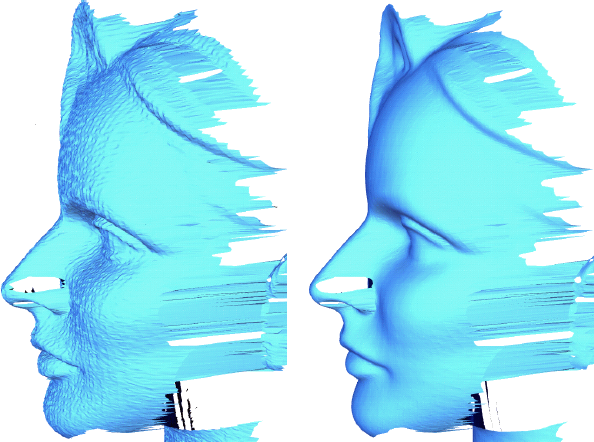
Motivation
- Advanced filtering



Kim, Rosignac: Geofilter: Geometric Selection of Mesh Filter Parameters, Eurographics 2005
Outline
- Motivation
- Spectral Analysis
- Diffusion Equation
- Numerical Solutions
Fourier Transform
- Represent a function as a weighted sum of sine and cosine functions

(1768-1830)

\[ f\of{x} \;=\; a_0 + a_1 \cos\of{x} + a_2 \cos\of{3x} + a_3 \cos\of{5x} + a_4 \cos\of{7x} + \dots \]
Fourier Transform
\[F(\omega) = \int_{-\infty}^{\infty} f(x) \, \func{e}^{-2\pi\func{i}\omega x} \func{d}x\]

\[f(x) = \int_{-\infty}^{\infty} F(\omega) \, \func{e}^{2\pi\func{i}\omega x} \;\func{d}\omega\]
Wikipedia: Fourier Transform and \(L^2\) Inner Product
Convolution
Smooth signal by convolution with a kernel function \[ h(x) \;=\; f * g \;:=\; \int f(y) \cdot g(x-y) \,\func{d}y \]
Example: Gaussian blurring



Convolution
Smooth signal by convolution with a kernel function \[ h(x) \;=\; f * g \;:=\; \int f(y) \cdot g(x-y) \,\func{d}y \]
Convolution in spatial domain ⇔ Multiplication in frequency domain \[ H\of{\omega} \;=\; F\of{\omega} \cdot G\of{\omega} \]
Filtering with Fourier Transform
- Spatial domain \(f(x) \rightarrow\) frequency domain \(F(\omega)\)
\[ F(\omega) = \int_{-\infty}^{\infty} f(x) \, \func{e}^{-2\pi \func{i}\omega x} dx\] - Multiply by low-pass filter \(G(\omega)\)
\[ F(\omega) \leftarrow F(\omega) G(\omega)\] - Frequency domain \(F(\omega) \rightarrow\) spatial domain \(f(x)\)
\[ f(x) = \int_{-\infty}^{\infty} F(\omega) \, \func{e}^{2\pi \func{i}\omega x} dx\]
Filtering with Fourier Transform



Filtering with Fourier Transform


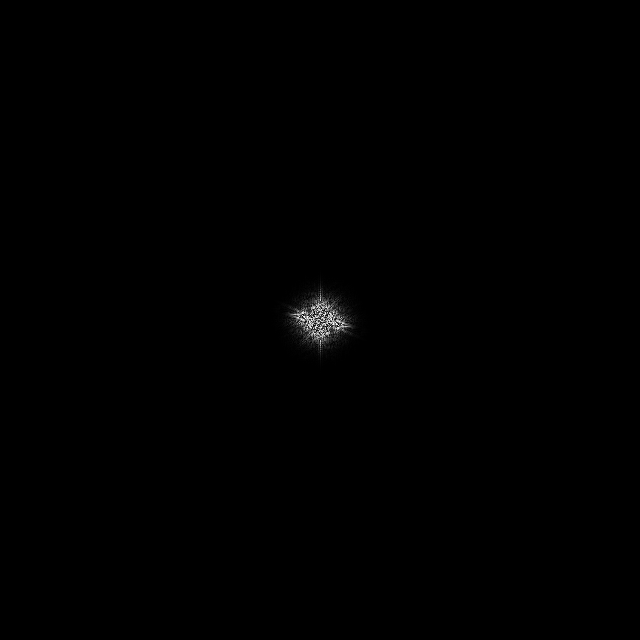

Spectral Analysis for Meshes
- Fourier transform requires functional representation
- How to generalize to meshes?
- Observation: Complex waves are eigenfunctions of Laplacian \[\Delta e^{2 \pi i \omega x} = \frac{\func{d}^2}{\func{d}x^2} \func{e}^{2 \pi \func{i} \omega x} = -(2 \pi \omega)^2 \func{e}^{2 \pi \func{i} \omega x}\]
- Idea: Use eigenfunctions of discrete Laplace-Beltrami operator as spectral basis
Discrete Laplace-Beltrami
Function values sampled at mesh vertices \[\vec{f} = [f_1, f_2, \ldots, f_n] \in \R^n\]
Discrete Laplace-Beltrami (per vertex) \[ \laplace_{\set{S}} f\of{v_i} := \frac{1}{2A_i} \sum_{v_j \in \set{N}_1\of{v_i}} \left( \func{cot} \alpha_{ij} + \func{cot} \beta_{ij} \right) \left( f \of{v_j} - f \of{v_i} \right)\]

Discrete Laplace-Beltrami
- Discrete Laplace operator (per mesh)
- Sparse matrix \(\mat{L} = \mat{DM} \in \R^{n \times n}\)
\[ \matrix{\vdots \\ \laplace_\set{S} f\of{v_i} \\ \vdots} \;=\; \mat{L} \cdot \matrix{\vdots \\ f \of{v_i} \\ \vdots} \]
Discrete Laplace-Beltrami
- Discrete Laplace operator (per mesh)
- Sparse matrix \(\mat{L} = \mat{DM} \in \R^{n \times n}\)
\[ \mat{M}_{ij} \;=\; \begin{cases} \func{cot}\alpha_{ij} + \func{cot}\beta_{ij}, & i \ne j \,,\; j \in \set{N}_1\of{v_i} \\ - \sum_{v_j \in \set{N}_1 \of{v_i}}\of{ \func{cot}\alpha_{ij} + \func{cot}\beta_{ij} } & i=j \\ 0 & \text{otherwise} \end{cases} \]
\[\mat{D} = \func{diag}\of{ \dots, \frac{1}{2A_i}, \dots}\]

Spectral Mesh Analysis
- Discrete Laplace-Beltrami matrix \(\vec{L}\)
- Eigenvectors are “natural vibrations”
- Eigenvalues are “natural frequencies”

Levy, Zhang: Spectral Mesh Processing, SIGGRAPH Courses 2010
Spectral Mesh Analysis
- Setup Laplace-Beltrami matrix \(\vec{L}\)
- Compute \(k\) smallest eigenvectors \(\{\vec{e}_1, \ldots, \vec{e}_k\}\)
- Reconstruct mesh from those (component-wise)
\[\begin{eqnarray} \vec{x} &:=& \left[ x_1, \dots, x_n \right] \\ \vec{x} &\leftarrow& \sum_{i=1}^k \, \left( \trans{\vec{x}} \vec{e}_i \right) \vec{e}_i \end{eqnarray}\]
\[\begin{eqnarray} \vec{y} &:=& \left[ y_1, \dots, y_n \right] \\ \vec{y} &\leftarrow& \sum_{i=1}^k \, \left( \trans{\vec{y}} \vec{e}_i \right) \vec{e}_i \end{eqnarray}\]
\[\begin{eqnarray} \vec{z} &:=& \left[ z_1, \dots, z_n \right] \\ \vec{z} &\leftarrow& \sum_{i=1}^k \, \left( \trans{\vec{z}} \vec{e}_i \right) \vec{e}_i \end{eqnarray}\]
Spectral Mesh Analysis
- Setup Laplace-Beltrami matrix \(\vec{L}\)
- Compute \(k\) smallest eigenvectors \(\{\vec{e}_1, \ldots, \vec{e}_k\}\)
- Reconstruct mesh from those (component-wise)

Levy, Zhang: Spectral Mesh Processing, SIGGRAPH Courses 2010
Spectral Mesh Analysis
- Setup Laplace-Beltrami matrix \(\vec{L}\)
- Compute \(k\) smallest eigenvectors \(\{\vec{e}_1, \ldots, \vec{e}_k\}\)
- Reconstruct mesh from those (component-wise)

Levy, Zhang: Spectral Mesh Processing, SIGGRAPH Courses 2010
Outline
- Motivation
- Spectral Analysis
- Diffusion Equation
- Numerical Solutions
Diffusion Flow
- Diffusion equation
\[\frac{\partial f}{\partial t} = \lambda \Delta f\]
- \(\lambda\) is the diffusion constant
- \(\Delta\) is the Laplace operator
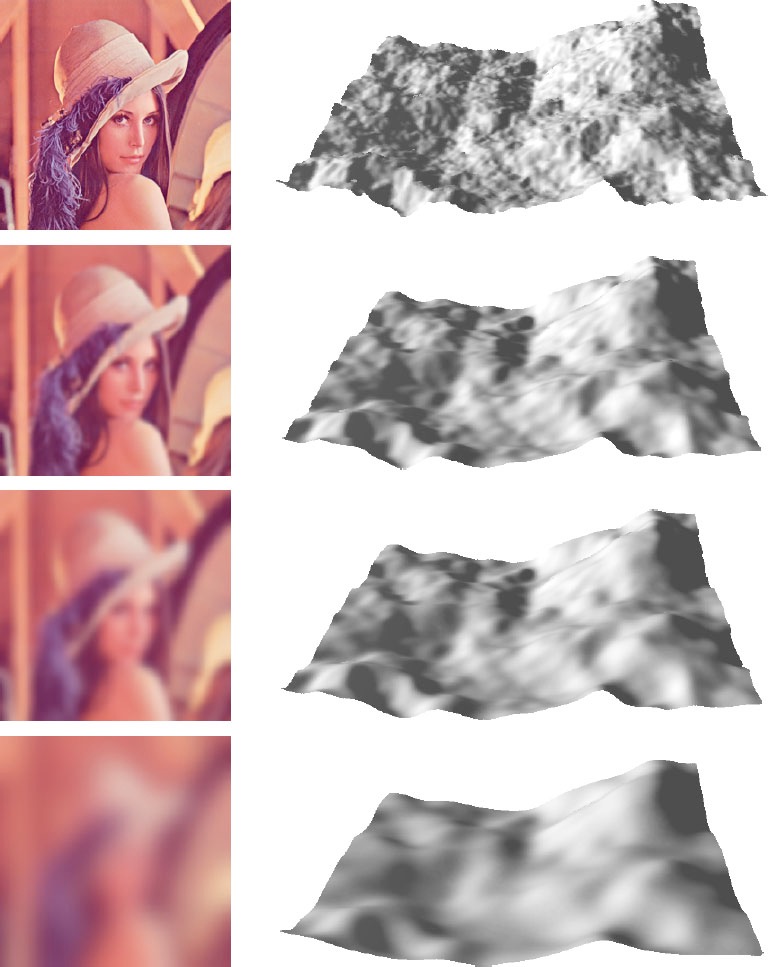
Diffusion Flow
- 2nd order elliptic PDE
\[\frac{\partial f(x,y,t)}{\partial t} \;=\; \lambda \left( \frac{\partial^2 f(x,y,t)}{\partial x^2} + \frac{\partial^2 f(x,y,t)}{\partial y^2} \right)\]
- Solve numerically
- Discretize in space & time
- Discretize time derivative
- Discretize spatial derivatives
Discretize in Space & Time
- Sample function \(f(x,y,t)\) on a regular grid with grid spacing \(h\) and time step \(\delta_t\) \[f[i,j,t] \;=\; f\left(i \cdot h, j \cdot h, t \cdot \delta t \right) \] \[i=1, \dots, n \quad j=1, \dots, m \quad t=0, 1, 2, \dots\]

Finite Differences
- Approximate \(f(x+h)\) from Taylor series \[ \begin{align} f(x+h) &\;=\; f(x) + h f'(x) + \frac{h^2}{2!} f''(x) + \ldots \\ &\;\approx\; f(x) + h f’(x) \end{align}\]

(1685-1731)
- Approximate \(f'(x)\) as \[f'(x) \;\approx\; \frac{f(x+h) - f(x)}{h}\]
Finite Difference Method
- Approximation of spatial derivatives
\[ \begin{align} f_{,x}[i,j,t] &\;\approx\; \frac{f[i+1,j,t] - f[i,j,t]}{h} &\text{forward difference} \\[2mm] f_{,x}[i,j,t] &\;\approx\; \frac{f[i,j,t] - f[i-1,j,t]}{h} &\text{backward difference} \\[2mm] f_{,x}[i,j,t] &\;\approx\; \frac{f[i+1,j,t] - f[i-1,j,t]}{2h} &\text{central difference} \end{align} \]
Finite Difference Method
- Approximation of higher-order derivatives
\[ \begin{align} f_{,xx}[i,j,t] &\;\approx\; \frac{f_{,x}[i,j,t] - f_{,x}[i-1,j,t]}{h} \\[2mm] &\;=\; \frac{f[i+1,j,t] -2f[i,j,t] + f[i-1,j,t]}{h^2} \end{align} \]
- Approximation of Laplacian
\[ \begin{align} \laplace f[i,j,t] &\;\approx\; f_{,xx}[i,j,t] + f_{,yy}[i,j,t] \\[2mm] &\;=\; \frac{f[i+1,j,t] + f[i-1,j,t] + f[i,j+1,t] + f[i,j-1,t] - 4f[i,j,t] }{h^2} \end{align} \]
Finite Difference Method
- Approximation of temporal derivative
\[ f_{,t}[i,j,t] \;\approx\; \frac{f[i,j,t+1] - f[i,j,t]}{\delta t}\]

(1685-1731)
- Leads to explicit Euler integration
\[ f[i,j,t+1] \;\approx\; f[i,j,t] + \delta t \cdot f_{,t}[i,j,t]\]

(1707-1783)
Diffusion Flow
- Continuous PDE \[\frac{\partial f(x,y,t)}{\partial t} \;=\; \lambda \left( \frac{\partial^2 f(x,y,t)}{\partial x^2} + \frac{\partial^2 f(x,y,t)}{\partial y^2} \right)\]
- Finite difference discretization \[\frac{f[i,j,t+1] - f[i,j,t]}{\delta t} \;=\; \lambda \frac{f[i+1,j,t] + f[i-1,j,t] + f[i,j+1,t] + f[i,j-1,t] - 4f[i,j,t] }{h^2}\] \[f[i,j,t+1] \;=\; f[i,j,t] + \delta t \lambda \frac{f[i+1,j,t] + f[i-1,j,t] + f[i,j+1,t] + f[i,j-1,t] - 4f[i,j,t] }{h^2}\]
( \(\leq 1\) in this case)
Diffusion in 2D
Diffusion Flow on Meshes
- Continuous PDE: \(\frac{\partial \vec{p}}{\partial t} \;=\; \lambda \Delta \vec{p}\)
- Discretization: \(\vec{p}_i \leftarrow \vec{p}_i + \delta t \, \lambda \Delta \vec{p}_i\)



Diffusion Flow on Meshes
- Problem: Time step needs to be very small to give stable results when using cotan Laplacian with area normalization
- Better results with normalized weights
(and ignoring the area term) \[\laplace \vec{p}_i \;=\; \frac{1}{\sum_{v_j \in \set{N}_1\of{v_i}} w_{ij}} \sum_{v_j \in \set{N}_1\of{v_i}} w_{ij} \left( \vec{p}_j - \vec{p}_i \right) \]- Uniform weights \(w_{ij} = 1\)
- Cotangent weights \(w_{ij} = \cot\alpha_{ij} + \cot\beta_{ij}\)
Uniform Laplace Discretization
- Smoothes geometry and triangulation
- Can be non-zero even for planar triangulations
- Vertex drift can lead to distortions
- Might be desired for mesh regularization


Uniform vs Cotan Discretization

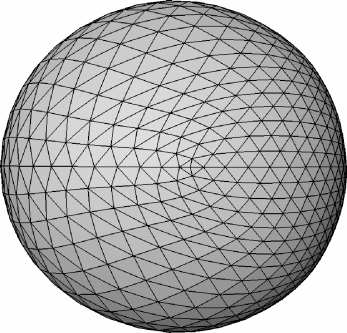




Outline
- Motivation
- Spectral Analysis
- Diffusion Equation
- Numerical Solutions
Numerical Integration
- Let’s write the position update in matrix notation
- Write all points \(\vec{p}_i^{(t)}\) in a large vector/matrix: \[\vec{P}^{(t)} = \trans{\left( \vec{p}_1^{(t)}, \ldots, \vec{p}_n^{(t)} \right)} \in \R^{n\times 3}\]
- Matrix version of explicit integration \[\vec{P}^{(t+1)} = (\vec{I} + \delta t \, \lambda \vec{L}) \, \vec{P}^{(t)}\]
- Matrix version of implicit integration \[(\vec{I} - \delta t \, \lambda \vec{L}) \, \vec{P}^{(t+1)} = \vec{P}^{(t)}\]
How to solve the linear system?
- Solve linear system in each iteration \[(\vec{I} - \delta t \, \lambda \vec{L}) \vec{P}^{(t+1)} = \vec{P}^{(t)}\]
- Matrix \(\vec{L} = \vec{DM}\) is built from Laplace weights \[\mat{M}_{ij} \;=\; \begin{cases} \func{cot}\alpha_{ij} + \func{cot}\beta_{ij}, & i \ne j \,,\; j \in \set{N}_1\of{v_i} \\ - \sum_{v_j \in \set{N}_1 \of{v_i}}\of{ \func{cot}\alpha_{ij} + \func{cot}\beta_{ij} } & i=j \\ 0 & \text{otherwise} \end{cases} \]
\[\mat{D} = \func{diag}\of{ \dots, \frac{1}{2A_i}, \dots}\]

How to solve the linear system?
- Solve linear system in each iteration \[(\vec{I} - \delta t \, \lambda \vec{L}) \vec{P}^{(t+1)} = \vec{P}^{(t)}\]
- Which solvers do you know?
- Gaussian elimination? 💣
- LU factorization? 💣
- Analyze the properties of your system matrix!
- very sparse (about 7 non-zeros per row) 😄
- but not symmetric 😢
How to solve the linear system?
- Matrix \(\vec{L} = \vec{DM}\) is not symmetric because of \(\vec{D}\).
Symmetrize it by multiplying with \(\vec{D}^{-1}\) from the left \[(\vec{D}^{-1} - \delta t \, \lambda \vec{M}) \vec{P}^{(t+1)} = \vec{D}^{-1} \vec{P}^{(t)}\] - Now the linear system is
- sparse 😄
- symmetric 😄
- positive definite 😄
- We can use much more efficient solvers!
- conjugate gradients 😘
- sparse Cholesky factorization 😍
Try it yourself!
Try it yourself!
Try it yourself!
Try it yourself!
Literature
- Botsch et al., Polygon Mesh Processing, AK Peters, 2010
- Chapter 4
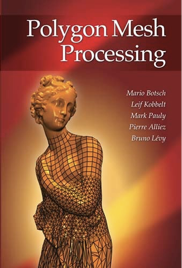
- Taubin, A Signal Processing Approach to Fair Surface Design, SIGGRAPH 1995
- Desbrun, Meyer, Schröder, Barr: Implicit Fairing of Irregular Meshes using Diffusion and Curvature Flow, SIGGRAPH 1999
Literature
- Botsch et al., Polygon Mesh Processing, AK Peters, 2010
- Chapter 4

- Taubin, A Signal Processing Approach to Fair Surface Design, SIGGRAPH 1995
- Desbrun, Meyer, Schröder, Barr: Implicit Fairing of Irregular Meshes using Diffusion and Curvature Flow, SIGGRAPH 1999